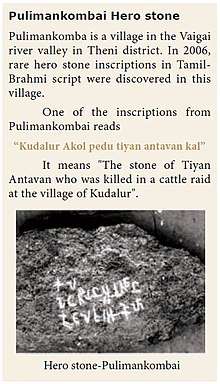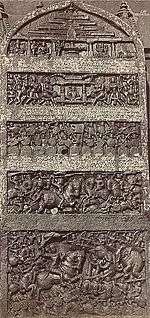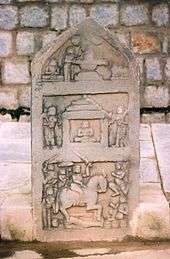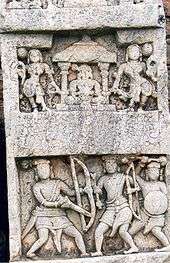Hero stone
A hero stone (Naṭukal in Tamil, Virakallu in Kannada)[1] is a memorial commemorating the honorable death of a hero in battle. Erected between the 6rd century BC[2] and the 18th century AD, hero stones are found all over India. They often carry inscriptions displaying a variety of adornments, including bas relief panels, frieze, and figures on carved stone.[3] Usually they are in the form of a stone monument and may have an inscription at the bottom with a narrative of the battle. The Earliest and oldest of such memorial Hero stones is found in the Indian state of Tamil Nadu is more than 2400 years old that is 4th Century BC.[4] According to the historian Upinder Singh, the largest concentration of such memorial stones is found in the Indian state of Karnataka. About two thousand six hundred and fifty hero stones,the earliest in Karnataka is dated to the 5th century AD.[5] The custom of erecting memorial stones dates back to the Iron Age (400 BC) though a vast majority were erected between the 4th century BC to 13th centuries AD.[6]

Description

A hero stone was usually divided into three panels, but occasionally, into four or five panels depending on the event. The upper panel depicts the subject worshiping a deity such as a Shiva linga, the middle panel depicts the hero sometimes seated in a palanquin or a shrine being lifted toward the heavens by apsaras (heavenly nymphs), and the lower panels would display battle scenes[7] One of the largest Viragallu, about 12 feet high is found in Betageri, Karnataka.[8] In Tamil Nadu Department of Archeology found several hundred hero stones that had been erected in the memory of warriors who sacrificed their lives defending their community or region. Those that are carved with inscriptions narrate the act of the hero, the battle, and the name of king who fought the battle. The stones are found alone or in groups, often near an irrigation tank or lake outside a village. [9] One hero stone dating to the 9th century Pallava King Dantivarman, depicts the hero riding a galloping horse beautifully dressed and carrying a spear.[10] Another was recovered at Pappapatti in Usilampatti taluk and probably dates from the 18th century. This stone shows a warrior posed heroically, accompanied by his wife who holds a flower. Creating hero stones had been prevalent since the Sangam period dating back 2300 years,[11] and continuing until the Nayaka and post-Nayaka period to about 19th century.[12] In March 2014, a hero stone dating to the 8th century Pandya country, with an inscription in Tamil vatteluttu script was found in Vellalankottai in the Tuticorin district.[6] and another that was installed by a woman in memory of her husband who killed a leopard preying in cattle that strayed into the hamlet.[13] In 2017, two rare hero stones raised in honor of warrior-women riding to a battle were found, dating back 13th century. [14]
Hero stones were not always made in honor of a person(s). The Atakur inscription (also spelt Athakur) is one such hero stone. It is dated to 939 A.D. and includes classical Kannada poetic inscription commemorating the death of the favorite hound of Ganga King Butuga II (the hound died fighting a wild boar).[15]
Gallery
 Hero stone from 12th century with Old Kannada inscription from the Tarakeshvara Temple at Hangal, Karnataka
Hero stone from 12th century with Old Kannada inscription from the Tarakeshvara Temple at Hangal, Karnataka_with_old_Kannada_inscription_at_the_Tarakeshvara_temple_at_Hangal.jpg) Hero stone from 12th century with Old Kannada inscription from the Tarakeshvara Temple at Hangal, Karnataka
Hero stone from 12th century with Old Kannada inscription from the Tarakeshvara Temple at Hangal, Karnataka Hero stone from 12th century with Old Kannada inscription from the Tarakeshvara Temple at Hangal, Karnataka
Hero stone from 12th century with Old Kannada inscription from the Tarakeshvara Temple at Hangal, Karnataka- Seven panel Hero Stone from 12th century with Old Kannada inscription from Siddapur taluk, Karnataka
- Seven panel Hero Stone from 12th century with Old Kannada inscription from Siddapur taluk, Karnataka
- Hero stone with 1160 AD Old Kannada inscription from the rule of Kalachuri King Bijjala in Kedareshvara temple at Balligavi in Shimoga district, Karnataka
- Hero stone with 11th- or 12th-century Old Kannada inscription in Kalleshvara temple in Bagali in Davangere district, Karnataka
- Hero stone with 1180 AD Old Kannada inscription from the rule of Kalachuri King Ahavamalla in Kedareshvara temple at Balligavi in Shimoga district, Karnataka
- Hero stone with old Kannada inscription dated 1235 AD from the rule of Yadava King Singhana II in Kaitabeshvara temple at Kubatur in Shimoga district, Karnataka
- Hero stone from 10th century with Old Kannada inscription at Trimurthi Narayana Gudi, Karnataka
 Hero stone from 10th century with Old Kannada inscription at Trimurthi Narayana Gudi, Karnataka
Hero stone from 10th century with Old Kannada inscription at Trimurthi Narayana Gudi, Karnataka Hero stone from Later Chalukya period at Siddhesvara temple at Haveri in Haveri district, Karnataka
Hero stone from Later Chalukya period at Siddhesvara temple at Haveri in Haveri district, Karnataka
 Murugamangalam hero stone, Tamil Nadu
Murugamangalam hero stone, Tamil Nadu- Narasinga Puram hero stone, 12th century AD, Tamil Nadu
 Tatchampadi hero stone, Tamil Nadu
Tatchampadi hero stone, Tamil Nadu- Olakkaravaadi hero stone 12th century AD, Tamil Nadu
Notes
- Filliozat, Jean (1991). Religion, Philosophy, Yoga: A Selection of Articles. Motilal Banarsidass. p. 151.
- "Hero Stones".
- "Hero-stone Memorials of India". Kamat Potpourri. Retrieved 15 March 2007.
- "Hero-stone discovered in Tamil Nadu". T. S. Subramanian. Retrieved 30 March 2014.
- Chapter "Memorializing death in stone", Singh (2009), p48
- Subramanian, T. S. (30 March 2014). "Hero-stone discovered in Tamil Nadu". The Hindu. Retrieved 10 December 2019.
- "Hungul. Sculptured memorial stone". Retrieved 27 October 2014.
- "12 feet high Viragal". Retrieved 27 October 2014.
- "Dolmens, Hero Stones and the Dravidian People". Retrieved 30 June 2009.
- "Pallava period 'herostone' unearthed in Vellore dt". Archived from the original on 26 January 2013. Retrieved 15 March 2007.
- "2,300-year-old hero stones found in Theni district". Chennai, India: The Hindu. 5 April 2006. Retrieved 14 May 2008.
- "'Hero stone' unearthed". The Hindu. Chennai, India. 22 July 2006. Retrieved 17 March 2007.
- "A hero stone tells a tale from eighth century". The Hindu. Chennai, India. 22 July 2006. Retrieved 13 October 2014.
- "Hero stones of women warriors found in Krishnagiri". Retrieved 3 April 2017.
- Altekar (1934), p351
References
- Singh, Upinder (2009). A History of Ancient and Early Medieval India:From the Stone Age to the 12th Century. India: Pearsons Education. ISBN 978-81-317-1120-0.
- Altekar, Anant Sadashiv (1934) [1934]. The Rashtrakutas And Their Times; being a political, administrative, religious, social, economic and literary history of the Deccan during C. 750 A.D. to C. 1000 A.D. Poona: Oriental Book Agency. OCLC 3793499.
External links
| Wikimedia Commons has media related to Hero stones. |
- Hero Stones
- "Hero-stone discovered in Tamil Nadu". T. S. Subramanian. Retrieved 30 March 2014.
- Hero-stone Memorials of India
- Rare Hero stone found near Erode
- Pallava period 'herostone' unearthed in Vellore dt.
- Government Museum Chennai
- Huntington Archive Hero Stone
- Ancient Hero stone goes missing in Goa